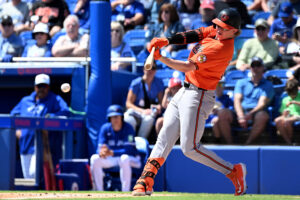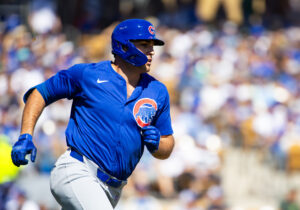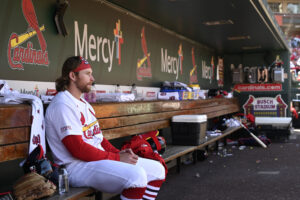Overview of the 1986 New York Mets
Next up in the “Reliving History” Series is a focus on 1986 New York Mets. The Mets team from that year was very strong. So strong in fact, that the team went onto win the National League East by 21 and 1/2 games!
Under the guidance of skipper Davey Johnson, the Mets concluded the regular season with a 108-54 record. As a team, New York had a +205 Run Differential and a team ERA of 3.11 that season. Furthermore, the Mets had a cumulative team batting line of: .263/.339/.401 which translated into an OPS+ of 106. Combine all of that together, the Mets led the National League in runs scored and batting average.
While there was plenty of team chemistry on the field, the 1986 New York Mets developed the reputation of being a team that everyone else around the league disliked. There are a few reasons why that was which will be discussed below.
Crazy is an Understatement
In an article by Robert Silverman on The Daily Beast, Silverman delves into some of the various descriptions that the league had about that year’s Mets team. Not only was the team viewed as a true outsider, the Mets had a reputation that every other team disliked.
As Silverman wrote in his article, “As pitcher Bobby Ojeda told Jeff Pearlman in his book, The Bad Guys Won, “We were a bunch of vile fuckers.” Furthermore, Silverman goes onto write, “The bulk of the team drank to excess after every game, win or lose, chased women like it was written into their contracts, and got into brawls both on and off the field, spurred by a quick-trigger rage to rival soccer hooligans.”
Based on those statements alone, it’s fair to view the ’86 Mets the same way the rest of baseball did. However, it didn’t stop there either as the Mets were secretly partaking in drugs as well. Suspicion had risen up around baseball regarding the Mets using drugs, but it’s long been speculated about by former players and fans alike.
As Silverman wrote in his article, “While it was common for the 1980s ballplayer to abuse the drug,” Pearlman wrote, “New York likely led the league. It was a matter of boasting a roster chock-full of on-the-edge, no-matter-what-it-takes, screw-my-health daredevils.
After a beer-soaked evening and early morning, it was almost as much of a necessity as batting practice.” Whether or not that was true, the Mets certainly found themselves in trouble on and off the field. For example, there were a total of four team fights that year. In addition, four players were arrested in Houston for fighting the police. That was just one of the many fights that the Mets experienced that year.
A Lighter Note
Despite all of those problems, the New York Mets had a special team that year. There was a lot of talent on their roster and they had the makings of a true winner. Below are some of the major contributors from that season’s team.
SCH Driven Lineup
One of the key driving forces within the Mets lineup was right fielder Darryl Strawberry. Strawberry, who was in his age-24 season that year, concluded the regular season with a slash line of .259/.358/.507 over the span of 562 plate appearances. Over that span, Strawberry led the Mets with 27 home runs, recorded 93 RBI, and was quite speedy on the base paths with 28 stolen bases. Furthermore, Strawberry recorded 72 walks and earned his third consecutive All-Star nod.
Besides Darryl Strawberry, Gary Carter was another pivotal member of the Mets squad that season. The future Hall of Famer, in the midst of his age-32 season, finished the season third in National League Most Valuable Player (MVP) Award voting, won a Silver Slugger Award, and also was named an All-Star. The right-handed catcher put up 24 home runs, 105 RBI, 62 walks, and 63 strikeouts over 573 plate appearances.
Yet another impact player for the 1986 New York Mets was first baseman Keith Hernandez. Coming off an eighth-place finish in National League MVP Award voting the year before, Hernandez finished fourth in the voting in 86. Over 652 plate appearances, Hernandez hit .310/.413/.446 and led the National League with 96 walks. In addition, besides the offense, the defense was a terrific quality of Hernandez’s game as well. Hernandez posted a .996 Fielding Percentage over 149 games which led to him also winning a Gold Glove Award that season.
Lenny Dykstra – The Table Setter
At the very top of the Mets lineup that year was centerfielder Lenny Dykstra. Dykstra was originally drafted by the New York Mets during the 13th round of the 1981 MLB Amateur Draft. In his second big league season in 1986, Dykstra had an impactful season overall. The left-handed, then 23-year old outfielder hit .295/.377/.445 over 498 plate appearances or 147 games.
In that span, Dykstra stole 31 bases and had 192 Total Bases. Although it wasn’t nearly as impactful as Dykstra’s age-30 season with the Philadelphia Phillies, having a leadoff hitter like Dykstra sure benefitted the Mets. Dykstra contributed so much that he finished nineteenth in National League MVP Award voting.
Dykstra really did damage against right-handers. Over 377 plate appearances against righties, Dykstra recorded 103 hits, 21 doubles, seven triples, eight home runs, 36 RBI, 42 walks, and 35 strikeouts. Furthermore, Dykstra posted a .884 OPS and a .331 Batting Average on Balls In Play (BABIP) over that sample.
Dykstra was primarily used as a starter that season for the Mets as he started in 98 games. However, the centerfielder was also used off the bench as a pinch hitter in 49 contests.
Doc Makes His Presence Felt Atop the Starting Rotation
On the pitching side, the most impactful arm for the Mets was right-hander Dwight Gooden. Coming off a season in which he won the National League Cy Young Award at 20, Gooden concluded the regular season in 1986 with a 2.84 ERA over 250.0 innings of work. In that span, Gooden posted a 3.06 Fielding Independent Percentage (FIP) along with a 7.2 K/9 rate.
Gooden would go onto earn an All-Star nod that year and finish seventh in National League Cy Young Award voting. In total, Gooden performed at a high enough level to post a 4.5 Wins Above Replacement (WAR) value which contributed to the Mets great record that year.
While Gooden was effective on both the road and at home, it was at home in Shea Stadium where the righty was really dominant. During 16 games at home, Gooden posted a 9-3 record, while holding opposing batters to a .183/.257/.288 slash line. That translated to a 2.20 ERA over 123.0 innings of work with 103 strikeouts and a 0.984 WHIP.
Additionally, Gooden’s splits that postseason were interesting. Gooden posted a 1.06 ERA over two starts against the Houston Astros in the NLCS. On the other hand, once the World Series rolled around, Gooden had an 8.00 ERA over two starts against the Boston Red Sox. Despite that though, Gooden still thrived in high-leverage situations during the regular season. In those situations, which accounted for 218 plate appearances, Gooden posted a .189 Opponent Batting Average Against (OBAA) and a .216 BABIP.
Bob, Ron, and Sid Have Big Seasons
Right behind Dwight Gooden in the Mets starting rotation was left-hander Bob Ojeda. Ojeda concluded the regular season with an 18-5 record posting a 2.57 ERA over 217 and 1/3 innings of work. 1986 was the only season of Ojeda’s 15-year big league career that he vied for the National League Cy Young Award. In fact, Ojeda finished fourth in voting that year and finished the season with the highest WAR (4.7) of his career.
Another impactful piece of the Mets starting rotation that season was right-hander Ron Darling. The 25-year old Darling concluded the regular season with a 2.81 ERA over 34 starts with a 3.43 FIP, 1.198 WHIP, and a 7.0 K/9 rate. Once the World Series rolled around, Darling seemed to take a big leap forward in his game. Over three starts, Darling posted a 1.53 ERA over 17 and 2/3 innings of work.
The third part of the three-headed monster was left-hander Sid Fernandez. Fernandez wrapped up the regular season with the first of two All-Star nods of his big league career and finished seventh overall in National League Cy Young Award voting. One of the more mysterious factors was Fernandez’s first and second half splits that year. During the first half of the season over seventeen starts, Fernandez posted a 2.67 ERA with a .181 OBAA. Once the second half of the season rolled around, Fernandez had a 4.69 ERA with a .270 OBAA.
McDowell Shines at The Back of the Bullpen
As is the case with any World Series bound team, success can’t be had if the team doesn’t have a strong bullpen. That was especially true when it came to right-hander Roger McDowell and left-hander Jesse Orosco. Together as a duo, McDowell and Orosco combined for 43 saves that season.
McDowell, who was in his second season pitching in the big leagues, was coming off a rookie season in which he finished sixth in National League Rookie of the Year Award voting. Furthermore, the right-hander finished 52 games for the Mets posting a 3.02 ERA over that span. Over that sample, McDowell put up an ERA+ of 119 and a 3.22 FIP.
After being drafted by the organization during the third round of the 1982 MLB Amateur Draft, McDowell did especially well at Shea Stadium. McDowell held opposing hitters to a .183/.261/.211 slash line with a .222 BABIP at home. Even more impressive was McDowell’s stats during save situations. Over the 22 saves that McDowell recorded in 1986, the righty posted an opponent batting average against line of: .101/.153/.109. Talk about dominating!
The Orosco Show
In addition, left-hander Jesse Orosco was very good as well. In his age-29 season that year, Orosco closed out the regular season with a 2.33 ERA over 81.0 innings of work. Over that sample, Orosco had a 6.9 K/9 rate with a 3.61 FIP. While the regular season was great for Orosco overall, where he really shined was once the World Series came around.
During the World Series, Orosco pitched in four games – closing out two of them. Over those four appearances, Orosco posted a 0.00 ERA and had a 9.5 K/9 rate. Besides the World Series, Orosco was quite effective against the Astros in the NLCS as well. During that series, Orosco had a 3.38 ERA over eight innings of work with a 0.875 WHIP.
World Series or Bust Comes
Once the postseason rolled around, the Mets were dominant, but it certainly didn’t come easy. After winning the NLCS in six games, the Mets pushed the World Series to a Game Seven.
One of the main highlights during the World Series occurred during Game Six when Boston Red Sox first baseman Bill Buckner made the famous “Between the Legs” critical error. That error allowed the Mets to win the game with a final score of 6-5 during the tenth inning. However, the good luck for the Mets didn’t stop there.
Once Game Seven rolled around, the Mets offense really came out of the gates swinging especially in the sixth through eight innings. During those three innings, New York scored all eight of their runs and rallied as a team to hoist the World Series trophy as Champions. After a dominating performance by Boston Red Sox starting pitcher Bruce Hurst, the Red Sox pitching staff really melted.
For the Mets, the Championship really capped off a special year. The last time New York won a World Series was of course in 1969 when they were coined the “Amazin’ Mets” or “Miracle Mets”. Still to this day, the 1986 World Series Championship remains the only World Series title the Mets have won in the last thirty-four years despite playing in the 2000 World Series against the cross-town rival New York Yankees and the 2015 World Series against the Kansas City Royals.
Main Image
Embed from Getty Images






